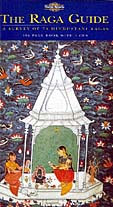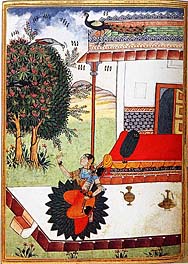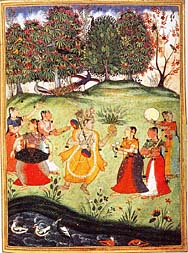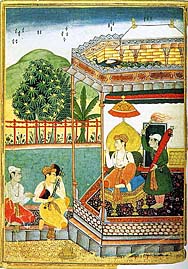| The Raga
Guide: A Survey of 74 Hindustani Ragas Edited by Joep Bor. Nimbus Records and the Rotterdam Conservatory of Music. 1999, viii + 184pp., notation, 40 color plates, glossary, bibliography, and 4 audio CDs. |
|
| This book and four CD
set is the first introductory survey of Hindustani ragas that presents written raga
descriptions and musical notations with matching recorded performances. The Raga Guide
represents the results of a 15-year project designed to document present-day raga
performance, carried out by editor Joep Bor and an international team of authors,
advisors, translators and performers. Attractively packaged in a small book format (14 x
25cm) with inside cover CD sleeves, the work provides a detailed discussion of the term
raga—the melodic basis of Indian classical music—and an anthology of 74 of the
most well-known and commonly performed North Indian ragas. The four compact disk recordings present the most striking departure from previous scholarly reference works on raga, offering beginning listeners a rich aural entry point into the world of Hindustani music. Most existing texts in English (such as Kaufmann, Danielou) are limited to written descriptions and notated examples, in some cases (as in Subbha Rao's "Raganidhi") presenting musical notation only in Devanagiri script. The recently revised theoretical text, The Rags of North Indian Music by Nazir Jairazbhoy, has an accompanying audio cassette presenting the melodic characteristics of eight ragas, however these short performances serve to illustrate differences between musical theory and performance practice rather than present a melodic guide. The Batish Institute's "Ragopedia" identifying over 650 Hindustani ragas in a seven volume set is extensive but no match for the Nimbus Records production; ragas are identified by ascending and descending scales, and a companion CD presents computer playback of MIDI files containing melodic progressions (chalans) of ten ragas with sampled Indian solfege vocals. The Raga Guide's listeners are treated to 74 short, four to six minute raga sketches performed by four renowned soloists: Hariprasad Chaurasia (flute), Buddhadev DasGupta (sarod), and vocalists Shruti Sadolikar-Katkar and Vidyadhar Vyas. These miniature performances are easily located on the four CDs by their appearance in alphabetical order, following the raga discussions in the text. Given the guide's intended use as a directory, this sequence of otherwise unrelated ragas is clearly functional. Each performance encapsulates the essential musical characteristics of a particular raga. The artists took as their "miniature" model early 20th century raga performances on 78 rpm records. And despite the short length, none sounds hurried or lacking in musical subtlety. Three of the four artists begin their performances with the ascending and descending raga scale, and all present a brief unmetered introductory section (alap) followed by a short composition and improvisation. Together with the text descriptions, these excellent performances enable the listener to identify and differentiate the various ragas presented. They undoubtedly whet the appetite for full-blown raga performances, which are the next step for listeners now familiarized with the basic melodic features. The guide stops short of suggesting recordings for further listening. Recordings of Indian classical music are both numerous and accessible in the global marketplace, however recommended titles would have been a useful component for students and scholars alike. The book's introductory pages address the question "What is a Raga?" in terms of its structural features, classification systems, iconographic representations in ragamala paintings, and its present-day performance practice. Authors Suvarnalata Rao, Wim van der Meer, and Jane Harvey provide a historical overview of raga classification schemes and ragamala painting traditions, a description of the major Hindustani vocal and instrumental genres, and a brief explanation of the rhythmic system (tala).
|
|
| Audio
1 Raga Alhaiya Bilaval excerpt |
This informative introduction ends with a complete transcription of one raga performance as presented on the CD set—raga alhaiya bilaval (Audio 1)—and a description of the vocal performance, which allows the reader to compare the musical notation and written description with the recording. For those interested in this level of detail, both the writing and transcription are remarkably clear and precise. |
| Audio
2 Raga Bhairav excerpt |
The guide conveniently documents each raga on two facing pages, with the exception of raga bhairavi (pp. 34-36). This double page spread presents a short historical and analytical description of the raga, its ascent-descent scale pattern and characteristic melodic outline, and a transcription of the alap (the unmetered introduction) as performed on the CD. (For example, Raga Bhairav, written description pp. 32-33, illustration plate 5). Audio 2 |
| All music notation in the guide is presented both on Western staff and in Indian solfege. The song texts of vocal performances are given in Hindi (Devanagiri script) and English translation, although not in transliteration for the benefit of non-Hindi readers. Much of the information presented in the guide is based on the extensive knowledge and experience of one scholar-musician, the late Dilip Chandra Vedi (1901-1992), who composed fifty of the melodic outlines for the Raga Guide. In dedicating this work to his memory, the authors acknowledge the solid foundation he provided for this raga project at the Rotterdam Conservatory. At once concise, accurate, attractive and accessible, The Raga Guide is undoubtedly a fine tribute. | |
| A set of forty glossy color
plates of raga-ragini illustrations follow the raga descriptions, thirty-four of which
come from a Rajasthani ragamala ("garland of ragas") album dated c. 1610. The
personification of musical ragas and raginis as male and female images developed first in
poetry in the 14th century then in painting, and was linked to the association of ragas
with emotions and with particular times of day and seasons of the year. While musicians today generally see no direct link between such images and the emotions evoked by raga performance, the guide's authors include these exquisite and beautifully reproduced artworks for their "artistic, philosophical and historical significance, and because [the authors] believe they are an important key to understanding the musical meaning of individual ragas" (p. 5). Translations of the Sanskrit couplets that accompany the original paintings are provided in a numerical list, adding further to our appreciation of these wonderfully vivid illustrations. |
|
| One aspect of Hindustani performance practice on which The
Raga Guide remains curiously silent is the connection between raga performance and
stylistic schools of learning or family lineages. Historically the transmission of Indian
classical music from one generation to the next via oral tradition has emphasized several
identifiable performance styles (Neuman 1980:147). Today's
musicians may develop playing styles based on exposure to a variety of musical sources and
styles, nevertheless one's link with a respected guru and an established musical lineage
and style still carries weight in Hindustani music circles. Some reference to performance
styles in general and to the musical training of the four solo artists in particular would
provide the general reader and beginning student with at least an elementary understanding
of the social organization of Hindustani musicians and its affect on performance practice.
Such an introduction would also help underscore for new listeners of Indian classical
music the fact that the performances on the CDs present but one artist's conception of
each raga, albeit a valid and respected one. This reservation aside, the guide remains a valuable and useful tool for a broad range of readers and listeners interested in Hindustani music. For ethnomusicologists, the short recordings and concise raga descriptions are eminently suited to classroom teaching (and from my own experience, a godsend in introductory world music classes!). For Indian music students and scholars alike, this musicological reference work offers a wealth of detail in one small volume: beyond the raga descriptions the guide includes a lucid explanation of notation and transcription, extensive endnotes, a comprehensive glossary and a two-page bibliography. A CD track listing of raga performances along with their performers is not printed in the book but can be found at the Nimbus Records website. The web pages present the book's preface, several sections of the introduction, and the historical and analytical descriptions of four ragas (Hindol, Kedar, Malkauns, and Ramkali). These online excerpts will be of particular interest to prospective buyers; they include the colorful ragamala paintings associated with the four ragas (reproduced in the guide between pp. 168 and 169), the carefully notated transcriptions of the introductory alap performances (but unfortunately not the explanatory note on transcription, pp. vii-viii), the Hindi lyrics and accurate English translations of the two sung performances (ragas Hindol and Ramkali), and full-length RealAudio samples of all four ragas. With adequate sound quality, the website's reproduction of these four raga sketches offers visitors sample performances by all four solo artists. The accessibility of The Raga Guide combined with its affordable price ($42.29 at amazon.com) will attract both occasional and seasoned listeners, musicians and non-musicians, and will undoubtedly render it an indispensable item for all music libraries. For this reviewer, a second volume containing more of the current Hindustani raga repertoire is eagerly awaited. Alison Arnold References Batish, Shiv Dayal, and Ashwin Batish. 1989. Ragopedia: Exotic Scales of North India. Santa Cruz, Cal.: Batish Institute of Indian Music and Fine Arts. See also www.batish.com/archives/rago1/ Danielou, Alain. 1980. The Ragas of North Indian Music. New Delhi: Munshiram Manoharlal. Jairazbhoy, Nazir A. 1995. The Rags of North Indian Music: Their Structure and Evolution. 2d ed. Bombay: Popular Prakashan. With accompanying audio cassette. Kaufmann, Walter. 1968. The Ragas of North India. Bloomington: Indiana University Press. Neuman, Daniel. 1980. The Life of Music in North India: The Organization of an Artistic Tradition. Detroit: Wayne State University Press. Reprinted 1990, University of Chicago Press. Subba Rao, B. 1993 [1956-1966]. Raganidhi: A Comparative Study of Hindustani and Karnatak Ragas. Madras: The Music Academy. |
|



